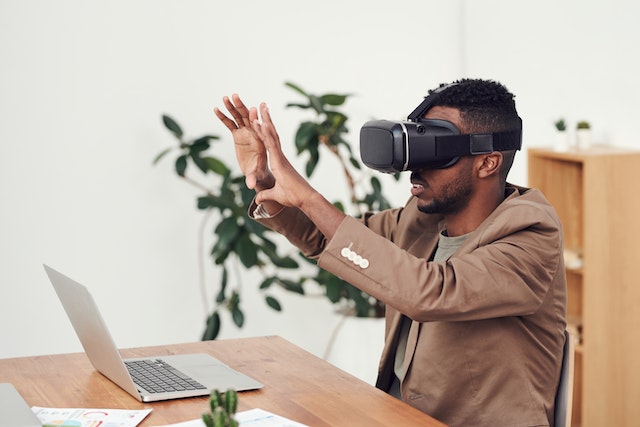As we venture further into the digital age, technological advancements continue to reshape the way we work and collaborate. Among these innovations, virtual reality (VR) has emerged as a transformative tool in the realm of remote work. This immersive technology has the potential to bridge geographical gaps, foster collaboration, and enhance productivity by offering novel ways of interacting and communicating within a virtual environment.
In this article, we will delve into the role of VR in remote work and collaboration, examining its benefits, potential drawbacks, and future trajectory. By understanding the implications of this cutting-edge technology, we can better prepare ourselves for the new era of work that awaits us.
The Evolution of Remote Work
The concept of remote work is not new. Telecommuting, or working from home, began as early as the 1970s, when employees started using modems and early computer networks to connect with their offices. However, it wasn’t until the 1990s that remote work truly took off, thanks to the widespread adoption of the internet and the proliferation of personal computers.
The 21st century saw the rise of cloud-based services, video conferencing tools, and project management software, which further enabled remote work. The COVID-19 pandemic accelerated the adoption of remote work models, forcing companies to adapt and proving that employees could work efficiently from home.
Now, with the advent of VR, the possibilities for remote work and collaboration are expanding even further.
Virtual Reality in Remote Work
Virtual reality has the potential to revolutionize remote work by creating immersive, interactive environments that closely mimic real-life interactions. With the use of VR headsets and other peripherals, employees can enter a virtual workspace and engage with colleagues, clients, and stakeholders in a way that feels more immediate and natural than traditional video conferencing.
Virtual Offices and Workspaces
One of the key benefits of VR is its ability to create virtual offices and workspaces that are tailored to the needs of individuals and teams. These environments can be customized to include conference rooms, private offices, and collaborative spaces that foster creativity and innovation.
In a virtual office, employees can access digital resources such as documents, spreadsheets, and presentations, just as they would in a physical office. Moreover, they can engage with 3D objects and models, enabling them to better visualize complex data and streamline decision-making processes.
Enhanced Communication and Collaboration
VR offers a more engaging and immersive form of communication, which can lead to stronger interpersonal connections among team members. The use of avatars can help humanize virtual interactions, allowing for better interpretation of non-verbal cues, such as body language and facial expressions, which are often lost in traditional video conferencing.
In addition, VR enables users to collaborate in real-time on shared projects within the virtual environment. This can include working on 3D designs, brainstorming ideas on a virtual whiteboard, or editing documents simultaneously. By providing a shared space for collaboration, VR can help to overcome the isolation and disconnection that can sometimes arise from remote work.
Training and Skill Development
Virtual reality has already proven to be an effective tool for training and skill development across various industries, such as healthcare, aviation, and manufacturing. By providing a realistic, immersive environment, VR can help employees gain practical experience and develop their skills without the risks or costs associated with real-world training scenarios.
In the context of remote work, VR-based training can be especially beneficial for onboarding new employees, as it allows them to become familiar with company culture and processes in a more engaging and hands-on way.

Challenges and Limitations
Despite its potential benefits, the adoption of VR in remote work and collaboration is not without its challenges and limitations.
Accessibility and Adoption
One of the primary barriers to widespread adoption of VR in remote work is accessibility. High-quality VR headsets and peripherals can be expensive, which may make them prohibitive for some companies and employees. Additionally, not all individuals have access to high-speed internet connections or powerful enough computers to run VR applications smoothly.
Moreover, the learning curve associated with using VR can be steep for some users, particularly those who are not accustomed to working with technology. This may lead to resistance or reluctance to adopt VR as a collaboration tool, especially among older or less tech-savvy employees.
Physical Discomfort and Safety
Prolonged use of VR headsets can lead to physical discomfort, including eye strain, headaches, and motion sickness. This discomfort can be exacerbated by the fact that VR headsets are still relatively heavy and cumbersome, making them less than ideal for extended periods of use.
There are also safety concerns associated with using VR in a home environment, where users may not have a dedicated space for VR activities. This can lead to the risk of tripping, bumping into objects, or other accidents while immersed in the virtual world.
Privacy and Security
As with any technology, privacy and security are important considerations when using VR for remote work and collaboration. In a virtual environment, sensitive information may be more vulnerable to hacking or unauthorized access, particularly if the VR platform is not adequately secured.
Additionally, the use of VR can raise concerns about employee surveillance and privacy. For example, companies may be able to monitor employees’ movements, interactions, and even biometric data within the virtual environment, leading to potential ethical and legal issues.
Future Trajectory and Potential Developments
As the technology continues to evolve, we can expect to see a number of advancements that will address some of the current challenges and limitations associated with using VR for remote work and collaboration.
Improved Hardware and Accessibility
Future developments in VR hardware, such as lighter, more comfortable headsets and more affordable peripherals, will likely make VR more accessible to a wider audience. As the technology becomes more mainstream, we can expect to see a reduction in costs and an increase in the number of companies and employees who are able to adopt VR for remote work.
Integration with Other Technologies
As VR continues to mature, we can expect to see greater integration with other technologies, such as augmented reality (AR), artificial intelligence (AI), and the Internet of Things (IoT). This convergence will lead to the creation of hybrid workspaces that combine the best elements of both physical and virtual environments, enabling more seamless and efficient collaboration.
For example, AI-powered virtual assistants could be integrated into VR workspaces to automate administrative tasks and streamline workflows, while AR could be used to overlay digital information onto the physical world, enhancing the remote work experience.
Standardization and Interoperability
As VR becomes more widely adopted in the workplace, we can expect to see greater standardization and interoperability between different VR platforms and applications. This will enable employees to more easily switch between different virtual environments and collaborate with colleagues and partners who may be using different VR systems.
Conclusion
Virtual reality has the potential to revolutionize remote work and collaboration, offering immersive and interactive experiences that closely mimic real-life interactions. As the technology continues to evolve and become more accessible, we can expect to see greater adoption of VR in the workplace, leading to a new era of work that is more connected, efficient, and engaging than ever before.
However, it is important to address the challenges and limitations associated with using VR for remote work, such as accessibility, physical discomfort, and privacy concerns. By overcoming these obstacles and harnessing the power of VR, we can unlock its full potential and reshape the way we work and collaborate in the digital age.
You might also like: Do U.S. Workers Really Have the Right to Unionize? The Facts vs. Reality









